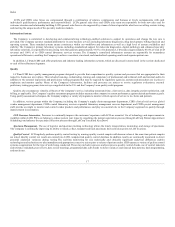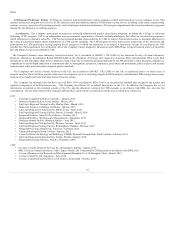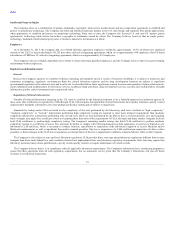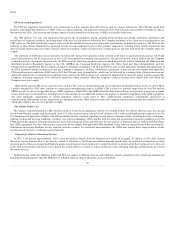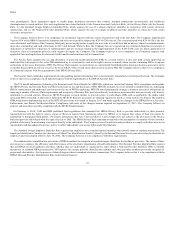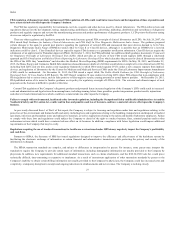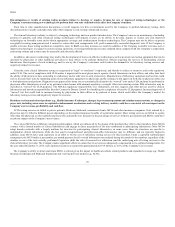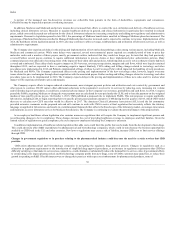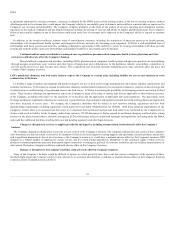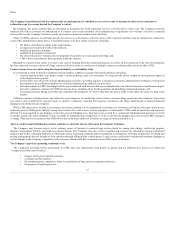LabCorp 2015 Annual Report Download - page 27
Download and view the complete annual report
Please find page 27 of the 2015 LabCorp annual report below. You can navigate through the pages in the report by either clicking on the pages listed below, or by using the keyword search tool below to find specific information within the annual report.
Index
The FDA has regulatory responsibility for instruments, test kits, reagents and other devices used by clinical laboratories. The FDA enforces laws and
regulations that govern the development, testing, manufacturing, performance, labeling, advertising, marketing, distribution and surveillance of diagnostic
products and regularly inspects and reviews the manufacturing processes and product performance of diagnostic products. LCD’s point-of-collection testing
devices are subject to regulation by the FDA.
There are other regulatory and legislative proposals that would increase general FDA oversight of clinical laboratories and LDTs. On July 26, 2007, the
FDA issued Draft Guidance for Industry, Clinical Laboratories, and FDA Staff: In Vitro Diagnostic Multivariate Index Assays . The guidance proposed
certain changes to the agency's general past practice regarding the regulation of certain LDTs and announced that most devices deemed to be In Vitro
Diagnostic Multivariate Index Assays (IVDMIAs) would either be Class II or Class III devices, although it is possible that an IVDMIA for a low-risk
indication could be class I. Class II medical devices typically require FDA clearance or a premarket notification submission. Class III devices require the
submission of an application for Premarket Approval (PMA). On October 3, 2014, the FDA published two additional draft guidance documents: Framework
for Regulatory Oversight of Laboratory Developed Tests (LDTs) which provides an overview of how FDA would regulate LDTs through a risk-based
approach and FDA Notification and Medical Device Reporting for Laboratory Developed Tests which describes the process for clinical laboratories to notify
the FDA of the LDTs they "manufacture" and describes the Medical Device Reporting (MDR) requirements for LDTs. On May 28, 2015, and October 22,
2015, the House Energy and Commerce Health Subcommittee released discussion drafts of a bill that would reform oversight of in vitro clinical tests (IVCTs),
including both LDTs and test kits, under a new regulatory framework in which FDA would regulate IVCTs under a new category separate from medical
devices, and regulation of laboratories by the Centers for Medicare and Medicaid Services (CMS) under the Clinical Laboratory Improvement Amendments
(CLIA) would be modernized. On November 16, 2015, the FDA issued a report titled, The Public Health Evidence for FDA Oversight of Laboratory
Developed Tests: 20 Case Studies (LDT Report). The LDT Report compiles 20 case studies involving LDTs where FDA alleges that non-compliance with
FDA regulations led to serious issues, such as false positive or false-negative results, causing potential or actual harm to patients. On December 29, 2015,
FDA published notice of its intent to finalize guidance on its policy for regulatory oversight of LDTs in 2016. The outcome and ultimate impact of such
proposals on the business is difficult to predict at this time.
Current FDA regulation of the Company’s diagnostic products and potential future increased regulation of the Company’s LDTs could result in increased
costs and administrative and legal actions for noncompliance, including warning letters, fines, penalties, product suspensions, product recalls, injunctions
and other civil and criminal sanctions which could have a material adverse effect upon the Company.
As previously discussed Item 1 of Part I of this report, the Company is subject to licensing and regulation under laws and regulations relating to the
protection of the environment and human health and safety, including laws and regulations relating to the handling, transportation and disposal of medical
specimens, infectious and hazardous waste and radioactive materials, as well as regulations relating to the safety and health of laboratory employees. Failure
to comply with these laws and regulations could subject the Company to denial of the right to conduct business, fines, criminal penalties and/or other
enforcement actions which would have a material adverse effect on its business. In addition, compliance with future legislation could impose additional
requirements on the Company that may be costly.
Pursuant to HIPAA, the Secretary of HHS has issued regulations designed to improve the efficiency and effectiveness of the healthcare system by
facilitating the electronic exchange of information in certain financial and administrative transactions while protecting the privacy and security of the
information exchanged.
The HIPAA transaction standards are complex, and subject to differences in interpretation by payers. For instance, some payers may interpret the
standards to require the Company to provide certain types of information, including demographic information not usually provided to the Company by
physicians. In addition, new requirements for additional standard transactions, such as claims attachments, and the ICD-10-CM Code Set, could prove
technically difficult, time-consuming or expensive to implement. As a result of inconsistent application of other transaction standards by payers or the
Company’s inability to obtain certain billing information not usually provided to the Company by physicians, the Company could face increased costs and
complexity, a temporary disruption in receipts and ongoing reductions in reimbursements and net revenues. The Company is working closely
27


